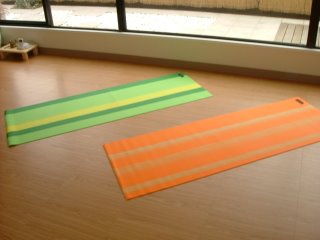 Because she's too modest to tell anyone, I wanted to note that Gwen is featured in this season's copy of Yogini magazine, and the studio got a nice write up in the back as well. Yogini comes out every three months, so check it out if you see it on the newstands.
Because she's too modest to tell anyone, I wanted to note that Gwen is featured in this season's copy of Yogini magazine, and the studio got a nice write up in the back as well. Yogini comes out every three months, so check it out if you see it on the newstands.The story they did with Gwen was a perfect fit for Yoga Garden. Gwen and one of the magazine's editors went to Chiba earlier this month and met a group of people who are trying to live more simply. The Hayashi family in particular has endeavored to live in a natural community that reduces waste and reliance on modern amenities. They live on a hilltop overlooking rice fields in a 200 year old house without air conditioning, plumbing, or electronics. They were interested in trying yoga, but there were no teachers in the area, so the editor of Yogini contacted Gwen and together they drove to the community to give them a lesson.
 What's most interesting about this community to me is that they have created their own currency called "awa." They use awa between themselves and 100 or so other spots around Chiba and Tokyo that have agreed to take part in the plan. Gwen was payed 2000 awa for her yoga lesson, and she used her awa to buy lunch and some organic vegetables from the farmer on her left in the photo. You can "pay" with awa at the barber, flower shops, bookstores, and many other stores. You could also use your awa to have snow cleared from your driveway, wood chopped, or your yard maintained.
What's most interesting about this community to me is that they have created their own currency called "awa." They use awa between themselves and 100 or so other spots around Chiba and Tokyo that have agreed to take part in the plan. Gwen was payed 2000 awa for her yoga lesson, and she used her awa to buy lunch and some organic vegetables from the farmer on her left in the photo. You can "pay" with awa at the barber, flower shops, bookstores, and many other stores. You could also use your awa to have snow cleared from your driveway, wood chopped, or your yard maintained.What I love about the idea of "awa" money is that it's working on a principle of direct energy exchange. Our modern monetary systems remove us several steps from this basic and life affirming feeling. We have all agreed to see money as a thing unto itself, not just paper that represents the sum of our labors. Imagine how different the world would be if we truly appreciated the energy and effort that went into getting those little pieces of paper that we throw around carelessly.
We can't all participate in an alternative currency like the Hayashis, but we can keep in mind the idea of energy exchange in our relationships. When you have a conversation with a friend, are both of you getting more of less equal energy from the dialouge? Are you giving too much energy, depleting your resources? Or taking too much, not seeing that your friend also needs to speak and share their opinions? Does your job give you as much energy (in terms of salary, free time, and happiness) as it takes from you? Anyway, something to think about and work on with small, mindful movements.
Take care!
Patrick
For more information about the awa money movement, check this site.




